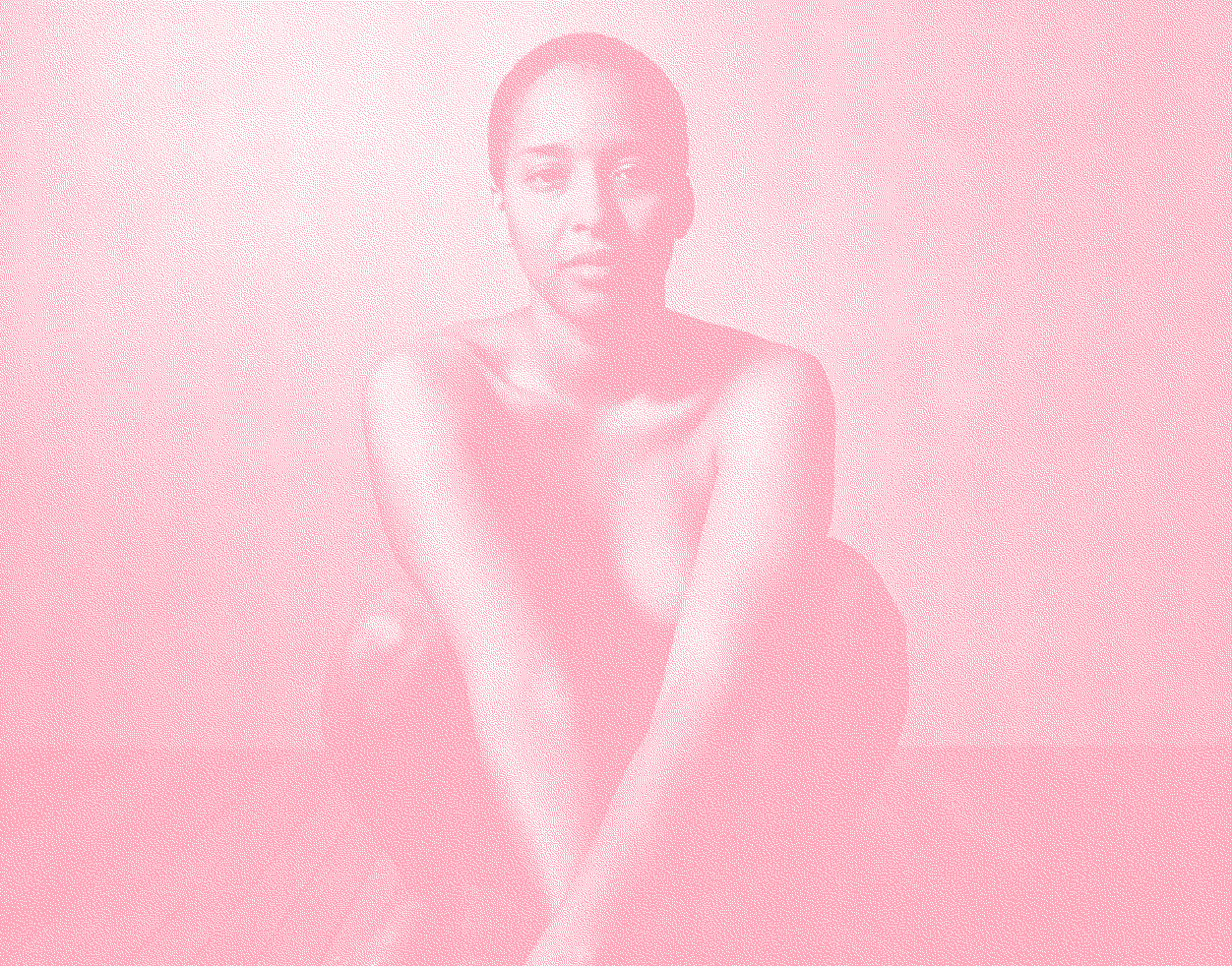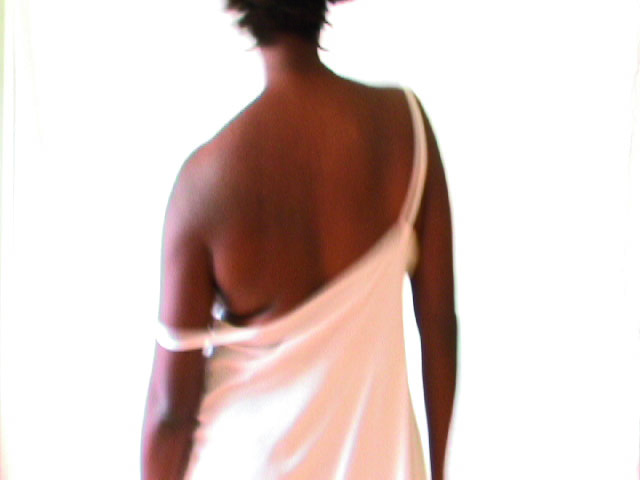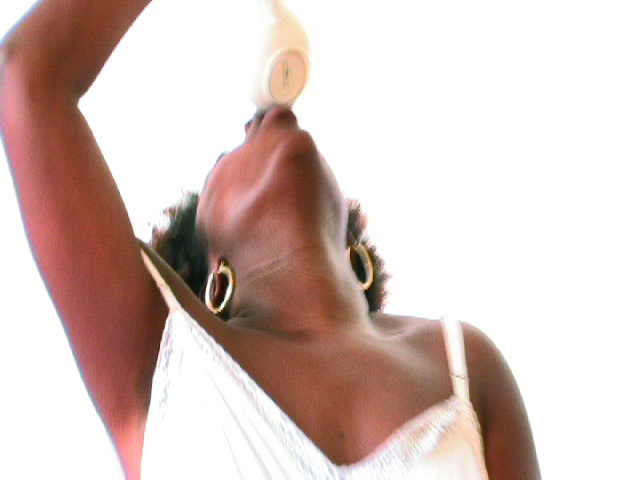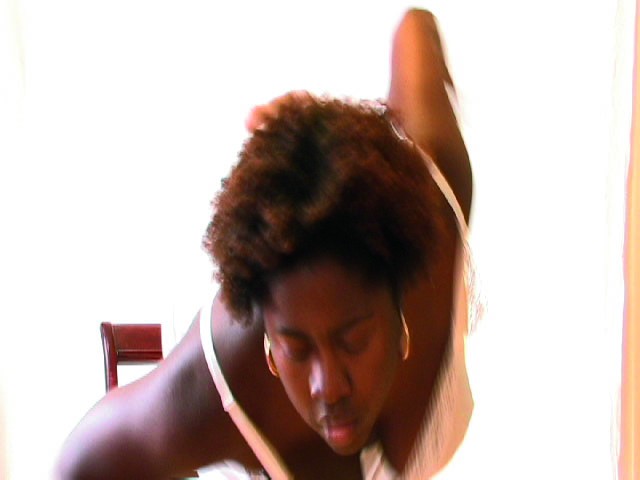In Conversation
Gabrielle Civil: We’re now in a moment where there are so many powerful, younger emerging artists and there are also a lot of powerful, older, and still vibrant artists—like Betye Saar. I just read her book Uneasy Dancer (Fondazione Prada, 2017) and she writes: “I’m an uneasy dancer in a slow dance. It is my 90th revolution around the sun. My work moves in a creative spiral within the concepts of passage, of crossroads, death, and rebirth, along with the underlying elements of race and gender; mystery and beauty remain a constant force behind my creative energy. This is the energy and the rhythm that spins my spiral, my dance.” It inspires me so much—she’s 90 years old and still making art, still representing! I’m curious, what do you think of our generational place? We’re now in the middle and I still think of myself as sort of young and emerging, but that’s not true.
Mankwe Ndosi: No, we’re mid-career—we’ve been doing it for 20 years. The realm of mid-career is expandable because you never actually know there’s a middle until there’s an end. (laughs)
Civil: But do you really think of yourself as mid-career?
Ndosi: I’ve been thinking about how to orient my work forward in a way that feels sustainable to my spirit, to my physical body and being a bit gentler on myself. I’ve been taking stock of what I know how to do and what I don’t know how to do, especially this year, because right now, I’m looking at all the monsters. I say that and I’m sure there will be a monster that I miss… But one of them is about being demure or showing false modesty in situations where it’s not necessary. So I’ve been rolling the idea of ego around in my mouth and on my tongue and between my breasts and behind my ears and to think about it, to just hold it and listen to it and listen to those places. I’m now in my mid–40s, so if there’s any time for me to really practice owning the space that I’m in and practice being clear on what I can do or can’t do… it’s now and there’s no time to waste. I’m claiming mid-career as a way of claiming my authority, which is not to say that there’s not a whole lot of growing to do. It’s a matter of claiming my own space, my own power and holding that lightly. As black women, it’s important that we speak our own power, our own authority so that people can see us from the outset.
Civil: Yes! When I think about Swallow the Fish (CCM Press, 2017), that era in my book is a very particular moment of my coming of age into performance art. I think about a number of people, yourself included, who are of a particular generation. There are people before and after us, who are still creating, but there was a kind of vibrancy in our moment. Maybe that’s how everyone thinks about their coming of age or maybe that’s a question I should ask you. I’m so in and out of the Twin Cities at this point, do you feel that the art scene here is as thriving as it was 10 years ago?
Ndosi: I do. I think there’s more to it, but there are places that need critique, worrying, and stretching. In our coming of age period, we were kind of novel to the scene and a lot of places were just coming into themselves as well. There were cohorts of artists learning from one another by participating in each other’s performances. But I do think there is a need for people like us, who are more experienced artists, to teach and to be in spaces where we can challenge people to push themselves and their artistry.
Civil: I think about that a lot because I learned how to practice as an artist by observing, speaking to, and collaborating with other artists. With the exception of two pieces, nothing was grant funded, it was bankrolled by my job, you know what I mean? I worked. It’s interesting to me as someone who didn’t go to art school and was self-taught by the community—my community was my teacher; books and performances and books about performances were my teacher. And for a long time I’ve wondered, how can the process of community feedback be stronger or more rigorous especially when we’re seeing or participating in something that could be better? What could be a better mechanism for that feedback? Or, do artists even want that feedback? I think some artists need support and want to go deeper but they’re not plugged into a network. Even if they’re within a community, there’s still not a clear mechanism.
Ndosi: That’s also one of the things I’ve been interested in, the feedback, but there’s also a part of me that still hasn’t completely exercised my inner teacher. I think I still have that desire, it’s just been angled towards using creativity inside community practice, about civic…
Civil: “Civic engagement” and “creative placemaking?”
Ndosi: Some of those words are very strange to me because places already exist. More like, how do we use creativity inside of conversation, inside of civic practices as a method for pulling apart some of these critical issues that institutions can’t resolve? Because they honestly don’t have the time or bandwidth for…
Civil: They don’t have an organic understanding of the communities or the situations that we’re trying to deal with.
Ndosi: We have to pull apart issues of economy, we have to pull apart issues of health and healing, we have to pull apart issues of grieving, we have to pull apart issues of conflict and policing, with or without them.
Civil: And using creativity as a means to avoid the same polarized-binary-gridlocked conversations or rehashing the same discursive positions in the same way. What would it mean for us to design an art school? What would that look like? There are people I know with art school experience and in terms of how the curriculum is structured and for students of color or even working-class students, there’s a very invisibilized, lack of critical attention to issues of race, gender, and class. So you have students that are trying to do something expressive yet feeling very vulnerable and marginalized in the midst of their own self-expression, that’s horrible.
Ndosi: It shouldn’t be that way.
Civil: Can you talk about con flama (2000), what it was like to work with Sharon Bridgforth?
Ndosi: Laurie Carlos directed that and Sharon worked on it. That was one of my favorite projects and places to work. There was a theatrical aspect, improvisation was encouraged and there was an understanding of the structures behind improvisation—those places almost get all of my rivers together. I improvised with another vocalist and it felt like home because of all the different possibilities. The way Laurie directs… my performance aesthetic is very much rooted in her minimalist, body as instrument approach. The idea of performance coming through you, coming through your body. The set and props are really secondary because the performance is inside of you, you’re bringing it out and aligning yourself and opening yourself up, engaging your true and present nature, channeling questions that you’re dealing with right now. The examinations of your own self, your own life, and own work are written into the script, into the performance, into the production. It was really fun. Working with Sharon is great. I think it was 2014 that we did River See in Minneapolis, Chicago, and Boston.

Civil: I saw River See, that had a really beautiful ensemble of people.
Ndosi: Yeah, it was spiritually aligned with a lot of Yoruba and Ifa practices and cosmologies. Not only in the conceptual and spiritual framework for the piece, but our roles and how we channeled our energy in the improvisations.
Civil: Do you feel like you’d be able to direct from those patterns yourself now that you’ve had multiple
experiences working with Laurie and Sharon?
Ndosi: It’s possible. I think it may take another era of work. I might come back to stories that channel through me but I haven’t been a writer in that way for a while. What’s interesting right now is, how can we find frames or ways of engaging different issues that everyday people don’t get to have their hands inside of? How do we worry inside out and upside down to implement new ideas?
Civil: Such deep questions, really at the heart of this new project I’m doing this year called Activating / Performance \ Activism. I believe so deeply in experimental art, art-making strategies, community and the moments in my life—in the classroom, in workshops, in conversations like this one where I can put those things together. I feel myself, I feel the group breaking into something new, something more possible. So I want in my solo performance actions, in collaborations and in larger community experiments to harness these practices, this energy. I’m also thinking specifically about protest—how we’re trained to do it (vigils, demonstrations, banners, marches) and if there are ways to infuse or interrupt or play with some of those forms. On some level, this is what Laurie did in her work and in her life. This is also connected to my artistic mantra: “the aim of my work is to open up space.”
I started out as a poet and a writer, then moved into conceptual art, infiltration and dissemination as a way of circulating language in new, ways through space. On some level, I was trying to break down the poetry reading, find a way to make it different, to move in a different cadence from spoken word or slam—forms I loved but wasn’t called to do. And those dissemination projects led me to understand that it wasn’t just language in space, or on the page—it was my body. That was the crucial element, the huge revelation and that led me to performance art.
I see so much emphasis on semantics and terminology, and I know how important that is yet a huge part of my spirit feels that words are never enough, will never be right. Why are we tripping so hard over them? I love words, but words are a mess. Which is why we need images, literal and figurative ones, figures of speech, and figures on canvas, vocal figures, scats and trills, and especially figures of the body. The love of all these things, the desire to bring poetry into performance, or really to make poetry in a new way by activating my body, these were the things that motivated me. And really what motivates me still today.
Ndosi: Performance and theater were my first loves. I grew up in theater but gravitated towards performance art because I was drawn to the different framings and working with artists like Laurie Carlos and Djola Branner. June Wilson’s piece Choice: Like Ripe Fruit (1998) was a revolution for me—the revelatory stories of black women in all kinds of situations. It was a very provocative framework at the time—the vignettes and images of us in underwear, bound at the wrists, wearing one high heel each, with tape over our mouths, eyes, or ears.
I started focusing on sound because I wanted to go deeper into the performance realm and it was the one thing I realized I couldn’t do without. Working with musicians and poets like Duriel E. Harris, Dee Alexander, Ed Wilkerson, Dushun Mosely, Mwata Bowden, Jeff Parker and Darius Savage took me on a long journey where I really grew into an improvising vocalist. But my performance, whether with musicians or theater artists, always has an emotional or theatrical base.
Civil: I don’t know how much of Swallow the Fish you’ve read but your piece Sema Yote (2002), part of the Naked Stages series, is discussed in the book. The way you walked onto the stage completely nude and played these beautiful homemade instruments and sang beautifully. But I could tell that so many people in the audience were very uncomfortable with you just being there in your skin. When I think of black women in the 21st century what comes to mind is how we’re so known and unknown at the same time. We’re never really portrayed as people with minds, it’s really much more about this overabundant flesh, this body that’s completely given and exposed, which has such serious ramifications in performance as you’re always giving your body…
There’s also a moment where I counterpoint your piece in my essay “White on White.” It takes place in a contemporary art gallery in the Twin Cities where there was a “performance” involving a helicopter and lights shining through the windows of the gallery. All of a sudden there was this conventionally attractive, slender white woman who took off all her clothes in the middle of the space as a kind of protest…
Ndosi: As a protest against the performance?
Civil: As a protest against this disembodied, extremely mechanistic, expensive high art project. “What we need to do is bring it back to the body right?” Or it could’ve been, “What we really need to do is bring the attention back to me and my body.” I don’t know. She said, “I just feel like taking off my clothes” and the little trickster in me said, “You know what? You should do that then.” One thing that I immediately thought in that moment was, “What if it had been me that done that?”
Ndosi: That’s always the question.
Civil: How would people respond? This was a couple years after Naked Stages, which was a long time ago. But there’s still something in me that’s interested in this. The scene at that gallery was very cold and I was there by myself—as is often the case. I mention your decision not to “strip” in your work because that’s such a loaded gesture. In the gallery, the white woman who stripped inserted the reality of her body in the space. In your performance, you appeared in the space as you were. Although the market is theoretically more open for black women and black art—these contemporary gathering spaces, do they really want us there?
Ndosi: To me, there’s also the question: Do we want to be there? Is our ideal integrating into a white space or having a space that we are a part of making, whether it’s a particular community or an intersection of communities?
Civil: Or is it that we want to be everywhere and that it takes a lot more work to start from scratch?
Ndosi: I don’t know about more. It’s different because you’re not compelled or expected to do the same kind of work in order to become part of that space. Whether it’s being the poster child, smiling at somebody, going with the flow, learning their rules or fighting their rules. It’s still difficult, but at times, it’s harder to get something in its groove to move than it is to prototype.
Civil: It’s easier to make a culture than to change a culture and if you’re changing a culture, who are you changing it for?
Ndosi: Exactly. It’s real and frustrating. It becomes about re-centering whiteness in a different way because you consistently have to be in relation to it. You’re compelled to be in relation to it, especially if you want access to certain resources and some days I don’t wanna!
Civil: To be a black woman is to overachieve, to be exceptional, and to always serve—you can’t just be you, you also have to serve everyone else. It’s the reason I’m tentative about certain community projects. Growing up there was a default expectation that black women were gonna put it all together and do whatever needed to be done. But maybe we want to lie down to read a romance novel and eat bonbons. (laughs) Really, a lot of times black women are taking on issues that really aren’t to our benefit. When we talk about reframing community frameworks and ways of engaging, that’s a lot of work. Whatever the next system is, a bunch of black women or female-identified people will automatically be tasked with setting it up, because that’s how it’s been culturally. It’s made to seem that any community imperative is more important than let’s say, you making a performance about your childhood, or you writing a poem about your heart, or you taking pictures of your feet, or whatever it is you want to do. That’s where I’m like oh wait, wait, wait…
Ndosi: It’s true that we are expected and expect ourselves and each other to be serving others. It’s really radical to pull out and sometimes the act of serving can be a matter of self-discipline or it can be self-enforced. You have to have your own limits. You have to place yourself squarely inside your story and as a priority, which is something I have often failed at. The world will use you up and find another black woman to replace you with and forget that you and your work ever existed. It’s really important for us to ask: Why are we doing this? What are we doing this for? What are we getting out of these situations?
Civil: Is this actually our work? Is this the thing that allows us to feel alive or is it something we’re burdened with? I once had a black student who told me that she rejected resilience and overachievement. At the tender age of 40, I had never heard anybody say anything like that. Not a young black woman in college. It made me think a lot. What expectations had I ingested?
At the same time, some of my students were caught up in a kind of performative activism. Sometimes, I just wanted to say to them: “You know what? Your job is not to come here and do institutional change work. Your job is to get an education. Why are you trying to do their work for them? You’re drafting all of these proposals… It can become really extractive. This is college. Why don’t you read Chinese poetry at the library? Why don’t you go fall in love? What’s happening with your homework? It’s stressful how much this is costing you. Do you really think you can solve racism here? In four years?” Or is there something else about the sustainability of community that needs to be tended? Maybe it doesn’t have to do with the institution at all.
Ndosi: Why do we need to engage with the system at all?
Civil: We can engage but it must be strategic. We can find ways to come together and work things out in solidarity, without having to show what we’re doing or even that we’re doing it. We don’t need their imprimatur to approve our vision, or weigh in, or allow us our actions. We may not even need them to admit everything they’re doing wrong. It’s important that we don’t make our movement, our vision, our language, our art, always about them. That can just become re-centering whiteness or other normative systems. I believe in generosity, solidarity and allyship, although I know that word has gotten a bad rap lately. I’m also deeply about freedom and liberation. Not just in a political sense, but in a personal, spiritual and aesthetic sense too. I don’t have it yet, but it’s where I’m trying to arrive.



Gabrielle Civil, Art Day, videography by Ellen Marie Hinchcliffe, 2007.
Ndosi: You talked about money before. How do we get our work done without money so we can do it whenever we feel like it and not be grant dependent? I haven’t written a grant for myself for a number of years now. It costs a lot of time, it takes a lot of time to write those things, you have to really focus to figure it out. It takes growing and learning, so I’m really interested in being clearer about where I put my time and where I put my focus. I’ve seen people disappear from their lives for a couple of months for grants, which could change your life for two to three years. But how innovative is it to focus on the places that have money?
Civil: I thought about money a lot when I performed a few months ago at the House of Wahala art auction in Texas. I just loved being around Wura Natasha-Ogunji. She’s a wonderful artist and was so generous to include live art action in the midst of art-selling. She also had a lot of clarity about money, about the fact that she wanted to have some of it, that she deserved it, and that it didn’t need to come out of the gift economy. She was like, the art world is a multibillion-dollar business, how come we can’t enter the market and get a piece of that?
Ndosi: It’s important to value ourselves critically.
Civil: But in the realm of performance art what does it mean to enter the market? Somehow, I picked a form that is about dematerialization. Maybe something in me didn’t want to be in the market or beholden to those with more money than me. So it’s dematerialization and hyper-embodiment. Just recently, I held a discussion about Swallow the Fish and there was only one other black woman in the group. That’s a recurrent dynamic right there: being the only one of two black women in the room. Anyway, she was interested in my discussion of the objectification and hyper-sexualization of black women.
In my performance Displays (after Venus) (2006), I take off my dress and she asked if that was just one more thing that would get turned against me? I knew exactly what she meant and it’s super tricky. Still, the claiming of my own body, it felt like I was coming closer to who it was that I wanted to be, something I was doing for myself. I just know that in culture, there’s both a preponderance of objectification and sexualization of women and as black women, there’s a modesty that can be really imposed on us and stifle our relationships with our bodies. We’ve historically been over-sexualized in representation. How much space is there for us to really claim sexuality? Or even nudity, which doesn’t have to be sexual.
Ndosi: I’m interested in a lot of those places. I agree with you that it can feel very powerful taking your body back in certain spaces, especially performative spaces.
Civil: Right. In the gallery, on stage, on the streets…
Ndosi: It’s interesting how these particular histories emerge through our individual stories, our lives and the complications that exist there. How can I make that interesting for myself and have that be a river that’s a part of it? There’s this expectation for black artists to constantly work inside of these conversations, but they organically come to the fold because we’re already dealing with these issues. Black folks can do or be anything and that doesn’t necessarily need to be inscribed.
Civil: Right. Because it’s already black.
Ndosi: It’s already there.












